Sources of Nonclassical Light for Quantum Networks
Nonclassical light is used to transmit qubits and/or entanglement over long distances. Because classical light cannot be used for this purpose, generating nonclassical states is essential for quantum networks. In general, nonclassical light cannot be described with the classical electromagnetic theory; instead, a quantized electromagnetic field and quantum mechanics are required. Most common forms of nonclassical light used in quantum information are Fock states (especially single-photon states) and squeezed states.

Spontaneous Parametric Down-Conversion (SPDC)
Spontaneous parametric down-conversion (SPDC) is a second-order nonlinear process in which a photon from a strong pump laser is converted to a photon pair. Although the down-conversion is a random process, a detection of one photon of the pair heralds the presence of the other. Thus, SPDC can be used as a probabilistic source of single photons. While building a scalable network with probabilistic photons may be difficult, SPDC is the most widely used technique for generating single photons. Because SPDC is easy to implement, the technology lends itself to a straightforward integration, and SPDC-based single photons are available at virtually any optical wavelength.
Another interesting property of SPDC photon pairs is that photons of the pair are typically entangled. SPDC-based entanglement sources are extensively used for quantum communications, particularly for sharing entanglement between distant nodes. Combining SPDC-generated photon pairs with optical elements such as beam splitters and detectors generates quantum light with unusual properties – the so-called exotic quantum states which could be useful for multipartite protocols, quantum error-correction, quantum repeaters, and other purposes. Some specific examples of SPDC-based sources developed for networking are listed below, as described by the researchers.
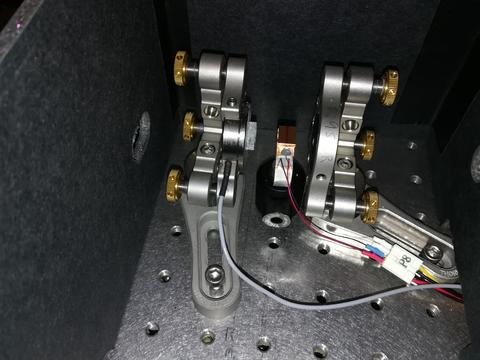
SPDC single-photon sources
Narrow linewidth single photon pair sources
We develop narrow-linewidth single-photon pair sources based on cavity-enhanced SPDC. By placing the SPDC non-linear crystal inside a cavity, the generated pairs are restricted to the modes of the cavity, which can be orders of magnitude narrower and brighter than the naturally broadband SPDC process. These sources are non-degenerate, meaning that each photon in the pair has a different wavelength. We have designed our sources to generate pairs such that one of the photons is compatible with quantum memory (in bandwidth and wavelength) and the second photon is optimized for fiber transmission. These sources are therefore “active” interfaces between quantum memory and fiber. Currently, we are collaborating on a compact version of this source using waveguides.
PI contacts: Oliver Slattery (primary contact), Lijun Ma, Thomas Gerrits.
Notable Publications:
O. Slattery, L. Ma, K. Zong and X. Tang, Background and Review of Cavity-Enhanced Spontaneous Parametric Down-Conversion, J. Res. Natl. Inst. Stand. Technol., 124, 124019 (2019), https://doi.org/10.6028/jres.124.019
O. Slattery, P. Kuo, L. Ma, and X. Tang, Narrow linewidth source of greatly non-degenerate photon pairs for quantum repeaters from a short singly-resonant cavity, Applied Physics B, 121, 413–419 (2015) https://doi.org/10.1007/s00340-015-6198-6
O. Slattery, L. Ma, P. Kuo, and X. Tang, Comparing the Linewidths from Single-Pass SPDC and Singly-Resonant Cavity SPDC, Quantum Communications and Quantum Imaging XII, San Diego, CA, 9615, 961507 (2015) https://doi.org/10.1117/12.2187059
Technology Readiness Level: 3: Proof-of-concept demonstrated, analytically and/or experimentally
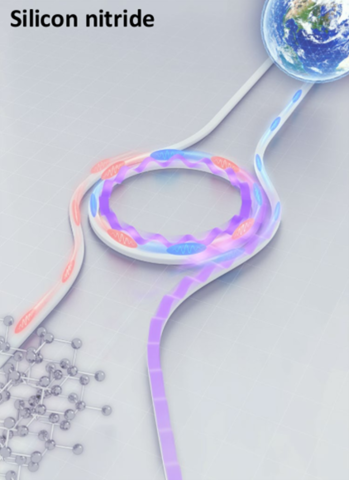
SPDC entangled sources
Integrated visible-telecom entangled pair sources
We develop a nanophotonic visible-telecom entangled photon pair source, using high-quality factor silicon nitride resonators. Using this integrated technology, we generate highly non-degenerate and narrow-band photon pairs with record purity and brightness. We demonstrated entanglement distribution over 20 km in fiber.
PI contact: Kartik Srinivasan
Notable Publications:
X. Lu, Q. Li, D. Westly, G. Moille, A. Singh, V. Anant, and K. Srinivasan, Chip-integrated visible–telecom entangled photon pair source for quantum communication, Nature Physics, 15, 373–381 (2019) https://doi.org/10.1038/s41567-018-0394-3
Technology Readiness Level: 5
A telecom source of polarization-entangled photons
We develop and demonstrate a source of polarization-entangled photon pairs using SPDC in a conventional telecom band (c-band). We observe the entanglement visibility above 93%. The source can be used to verify point-to-point entanglement distribution in a quantum network.
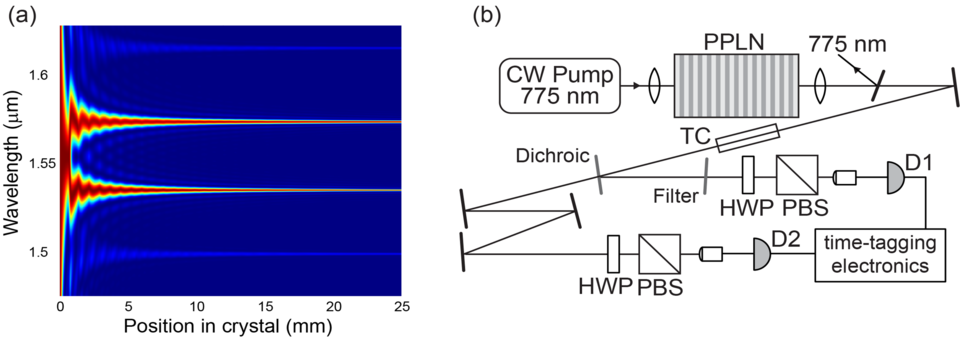
PI contact: Paulina Kuo
Notable Publications:
P. Kuo, V. Verma, and S. Nam, Demonstration of a polarization-entangled photon-pair source based on phase-modulated PPLN, OSA Continuum, 3, 295-304 (2020) https://doi.org/10.1364/OSAC.387449
P. Kuo, T. Gerrits, V. Verma, and S. Nam, Spectral correlation and interference in non-degenerate photon pairs at telecom wavelengths, Optics Letters, 41, 5074-5077 (2016) https://doi.org/10.1364/OL.41.005074
Technology Readiness Level: 5
Time-bin entangled photon sources
We experimentally implement a non-degenerate sequential time-bin entangled photon-pair source using a periodically poled potassium titanyl phosphate (PPKTP) waveguide at a clock rate of 1 GHz. The wavelengths of the signal and idler are 895 nm and 1310 nm, which are suitable for local and long-distance optical communications respectively. A silicon avalanche photodiode (APD) is used to detect the photons at 895 nm while PPLN waveguide based up-conversion detector is used to detect the photons at 1310 nm. The measured entangled-photon-pair flux rate is 650 pairs/s and the visibility for two-photon interference fringe is 79.4 % without noise subtraction.

PI contacts: Lijun Ma, Oliver Slattery, and Xiao Tang.
Notable Publications:
L. Ma, O. Slattery, T. Chang, and X. Tang, Non-degenerated sequential time-bin entanglement generation using periodically poled KTP waveguide, Optics Express, 17, 15799-15807 (2009), https://doi.org/10.1364/OE.17.015799
Technical Readiness Level: 3 - Proof-of-Concept Demonstrated, Analytically and/or Experimentally
Isolated particles (quantum dots, NV centers, single atoms, and ions)
An isolated single quantum particle can be used as a deterministic single-photon source. These most commonly include quantum dots (QDs), nitrogen vacancy centers (NVs), single atoms, and ions. One of the major technical challenges is ensuring that the excitation of the quantum particle produces a photon in a well-defined spatial mode. Other concerns include decoherence and purity of the produced quantum state as well as post-emission entanglement of the emitter and the flying photon.
QDs are single “artificial atoms” made of a few hundreds of real atoms within a semiconductor crystal. The excitation energy of a QD has a discrete spectrum. Typically, the energy of at least one of the excitations is below the bandgap energy of the semiconductor host. Therefore, a QD can be optically accessed and the excitation can be read out as a single photon. QD-based single-photon sources can generate up to a billion photons per second, can be optically integrated, and are intended to be fully turnkey. Some QDs can generate entangled photon pairs on demand. However, because their emission wavelengths are different from that used in telecommunications, transducers may be needed.
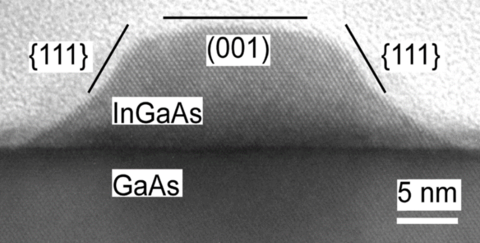
An integrated source of on-demand photons
We grow and characterize on-chip, cavity-embedded QD single-photon sources. Multiple QDs are created in single-crystal growth of InAs and embedded in single-crystal GaAs containing the cavities. We show high purity and high indistinguishability of single photons. Many cavity geometries have been developed to control the emission direction of these QDs. To enable highly efficient integrated single-photon circuits, on-chip emitters were developed. For other applications, out-of-plane emitters are made and optimized.
PI contacts: Richard Mirin, Marcelo Davanço, Kartik Srinivasan
Notable Publications:
S. Anders, C. Kim, B. Klein, M. Keller, and R. Mirin, Bimodal Size Distribution of Self-Assembled InGaAs Quantum Dots, Physical Review B, 66, 125309 (2002) https://doi.org/10.1103/PhysRevB.66.125309
L. Sapienza, M. Davanco, A. Badolato, and K. Srinivasan, Nanoscale optical positioning of single quantum dots for bright, pure, and on-demand single-photon emission, Nature Communications, 6, 7833 (2015) https://doi.org/10.1038/ncomms8833
M. Davanco, L. Jin, L. Sapienza, C. Zhang, J. De, V. Verma, R. Mirin, S. Nam, L. Liu, and K. Srinivasan, Heterogeneous integration for on-chip quantum photonic circuits with single quantum dot devices, Nature Communications, 8, 889 (2017) https://doi.org/10.1038/s41467-017-00987-6
T. Huber, M. Davanco, M. Müller, Y. Shuai, O. Gazzano and G.S. Solomon, Filter-free single-photon quantum dot resonance fluorescence in an integrated cavity-waveguide device, Optica, 7, 380-385 (2020) https://doi.org/10.1364/OPTICA.382273
T. Thomay, S.V. Polyakov, O. Gazzano, E. Goldschmidt, Z.D. Eldredge, T. Huber, V. Loo and G.S. Solomon, Simultaneous, full characterization of a single-photon state, Physical Review X, 7, 041036 (2017) https://doi.org/10.1103/PhysRevX.7.041036
Technology Readiness Level: 5
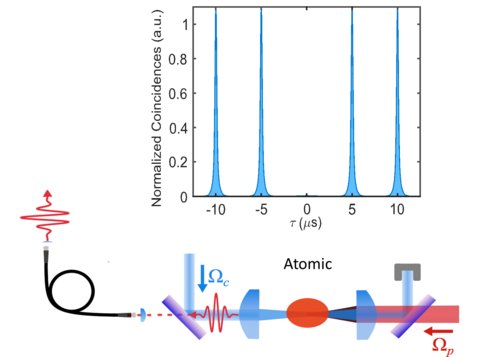
Atomic ensemble single photon sources
Rydberg-excited atomic ensembles can serve as a source for single photons, where the spatially extended nature of the ensemble naturally allows for single mode production. Rydberg interactions among atoms in the ensemble ensure that only a single photon is produced. We have used these properties to produce an efficient, pure, and indistinguishable single-photon source by collective excitation and de-excitation of a cold, trapped ensemble of atoms through a highly excited Rydberg state. Optimized for production rate, the source produces a fully single-mode (spectral, temporal, spatial, and polarization) photons with efficiency up to 10%. The single photon impurity due to multiphoton states is 5×10−4, indistinguishability is 0.98, and an average photon production rate is 12×103 s−1. Importantly, the photons are bandwidth matched to typical atomic sources and memories.
PI contacts: Trey Porto
Notable Publications:
D. P. Ornelas-Huerta, A. N. Craddock, E. A. Goldschmidt, A. J. Hachtel, Y. Wang, P. Bienias, A. V. Gorshkov, S. L. Rolston, J. V. Porto, On-Demand Indistinguishable Single Photons from an Efficient and Pure Source Based on a Rydberg Ensemble, Optica, 7, 813-819 (2020) https://doi.org/10.1364/OPTICA.391485
Technology Readiness Level: 4
Contacts
-
(301) 975-5887
-
(301) 975-4281
-
(301) 975-8473

